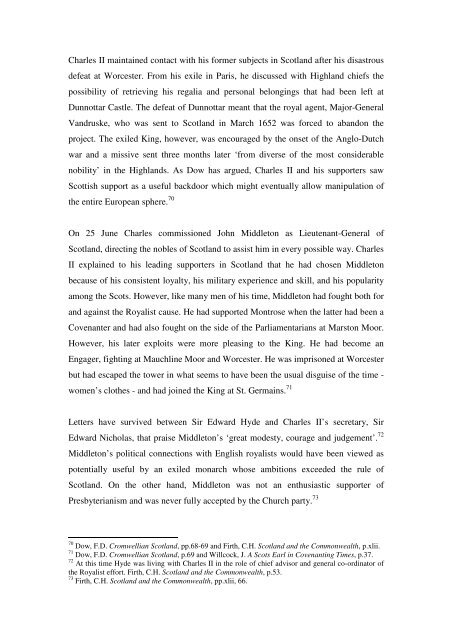The Glencairn Uprising, 1653-54 Helen Baker Department of ...
The Glencairn Uprising, 1653-54 Helen Baker Department of ...
The Glencairn Uprising, 1653-54 Helen Baker Department of ...
You also want an ePaper? Increase the reach of your titles
YUMPU automatically turns print PDFs into web optimized ePapers that Google loves.
Charles II maintained contact with his former subjects in Scotland after his disastrous<br />
defeat at Worcester. From his exile in Paris, he discussed with Highland chiefs the<br />
possibility <strong>of</strong> retrieving his regalia and personal belongings that had been left at<br />
Dunnottar Castle. <strong>The</strong> defeat <strong>of</strong> Dunnottar meant that the royal agent, Major-General<br />
Vandruske, who was sent to Scotland in March 1652 was forced to abandon the<br />
project. <strong>The</strong> exiled King, however, was encouraged by the onset <strong>of</strong> the Anglo-Dutch<br />
war and a missive sent three months later ‘from diverse <strong>of</strong> the most considerable<br />
nobility’ in the Highlands. As Dow has argued, Charles II and his supporters saw<br />
Scottish support as a useful backdoor which might eventually allow manipulation <strong>of</strong><br />
the entire European sphere. 70<br />
On 25 June Charles commissioned John Middleton as Lieutenant-General <strong>of</strong><br />
Scotland, directing the nobles <strong>of</strong> Scotland to assist him in every possible way. Charles<br />
II explained to his leading supporters in Scotland that he had chosen Middleton<br />
because <strong>of</strong> his consistent loyalty, his military experience and skill, and his popularity<br />
among the Scots. However, like many men <strong>of</strong> his time, Middleton had fought both for<br />
and against the Royalist cause. He had supported Montrose when the latter had been a<br />
Covenanter and had also fought on the side <strong>of</strong> the Parliamentarians at Marston Moor.<br />
However, his later exploits were more pleasing to the King. He had become an<br />
Engager, fighting at Mauchline Moor and Worcester. He was imprisoned at Worcester<br />
but had escaped the tower in what seems to have been the usual disguise <strong>of</strong> the time -<br />
women’s clothes - and had joined the King at St. Germains. 71<br />
Letters have survived between Sir Edward Hyde and Charles II’s secretary, Sir<br />
Edward Nicholas, that praise Middleton’s ‘great modesty, courage and judgement’. 72<br />
Middleton’s political connections with English royalists would have been viewed as<br />
potentially useful by an exiled monarch whose ambitions exceeded the rule <strong>of</strong><br />
Scotland. On the other hand, Middleton was not an enthusiastic supporter <strong>of</strong><br />
Presbyterianism and was never fully accepted by the Church party. 73<br />
70 Dow, F.D. Cromwellian Scotland, pp.68-69 and Firth, C.H. Scotland and the Commonwealth, p.xlii.<br />
71 Dow, F.D. Cromwellian Scotland, p.69 and Willcock, J. A Scots Earl in Covenanting Times, p.37.<br />
72 At this time Hyde was living with Charles II in the role <strong>of</strong> chief advisor and general co-ordinator <strong>of</strong><br />
the Royalist effort. Firth, C.H. Scotland and the Commonwealth, p.53.<br />
73 Firth, C.H. Scotland and the Commonwealth, pp.xlii, 66.
















